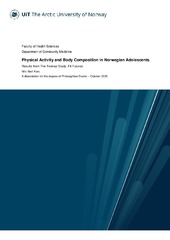| dc.contributor.advisor | Grimsgaard, Sameline | |
| dc.contributor.author | Aars, Nils Abel | |
| dc.date.accessioned | 2021-01-12T10:30:30Z | |
| dc.date.available | 2021-01-12T10:30:30Z | |
| dc.date.issued | 2021-02-04 | |
| dc.description.abstract | The present thesis has investigated the cross-sectional and prospective associations between self-reported and objectively measured physical activity with five objectively measured indices of body composition in Norwegian adolescents participating in the Tromsø Study Fit: Futures Cohort. The three included papers used regression analyses to assess the cross-sectional association between self-reported physical activity and body composition in first year of upper secondary high school, and whether self-reported or objectively measured physical activity predicted changes in body composition between first- and last year of upper secondary high school. A significant cross sectional association was observed between self-reported physical activity and waist circumference (girls only), fat- and lean mass index for both sexes, but self-reported physical activity generally did not predict changes to body composition between baseline- and follow-up. Changes in level of physical activity during follow-up was predictive of changes in fat mass index in boys and lean mass index in girls. Objectively measured physical activity at baseline did not predict changes in body composition in boys, whereas time spent in sedentary- and light intensity predicted changes in indices of lean mass in girls. No association was observed with BMI in either of the included papers. The findings are interpreted in light of the substantial changes that occur in both habits and body composition during adolescence, and shows that there are health benefits of remaining- or becoming physically active during this period. | en_US |
| dc.description.doctoraltype | ph.d. | en_US |
| dc.description.popularabstract | Physical activity is associated with body composition, but during adolescence there are substantial changes in both. This thesis looked at the association between physical activity and several indices of body composition in a group of Norwegian adolescents participating in the Tromsø Study: Fit Futures Cohort. Self-reported physical activity was associated with body composition in the first year, but this association did not remain prospectively, with self-reported physical activity generally not associated with changes in body composition over two years of follow-up. Similar findings were observed using objective measures of physical activity. Changes in self-reported physical activity between the two surveys predicted changes in fat mass in boys and lean mass in girls, and illustrate the positive effects of physical activity and the difficulties of untangling a relationship between two factors that are subject to natural changes during adolescence. | en_US |
| dc.description.sponsorship | The Fit Futures studies were funded by the UiT - The Arctic University of Norway, the University Hospital of North Norway and the Norwegian Institute of Public Health.
This PhD was funded by the UiT - The Arctic University of Norway. | en_US |
| dc.identifier.uri | https://hdl.handle.net/10037/20272 | |
| dc.language.iso | eng | en_US |
| dc.publisher | UiT The Arctic University of Norway | en_US |
| dc.publisher | UiT Norges arktiske universitet | en_US |
| dc.relation.haspart | <p>Paper I: Aars, N.A., Jacobsen, B.K., Furberg, A.‐S. & Grimsgaard, S. (2019). Self‐reported physical activity during leisure time was favourably associated with body composition in Norwegian adolescents. <i>Acta Paediatrica, 108</i>, 1122-1127. Also available at <a href=https://doi.org/10.1111/apa.14660>https://doi.org/10.1111/apa.14660</a>.
<p>Paper II: Aars, N.A., Jacobsen, B.K., Morseth, B., Emaus, N. & Grimsgaard, S. (2019). Longitudinal changes in body composition and waist circumference by self-reported levels of physical activity in leisure among adolescents: the Tromsø study, Fit Futures. <i>BMC Sports Science, Medicine and Rehabilitation, 11</i>, 37. Also available in Munin at <a href=https://hdl.handle.net/10037/17343>https://hdl.handle.net/10037/17343</a>.
<p>Paper III: Aars, N.A., Beldo, S., Jacobsen, B.K., Horsch, A., Morseth, B., Emaus, N., Furberg, A.S. & Grimsgaard, S. (2020). Association between objectively measured physical activity and longitudinal changes in body composition in adolescents: the Tromsø study fit futures cohort. <i>BMJ Open, 10</i>, e036991. Also available in Munin at <a href=https://hdl.handle.net/10037/20037>https://hdl.handle.net/10037/20037</a>. | en_US |
| dc.rights.accessRights | openAccess | en_US |
| dc.rights.holder | Copyright 2021 The Author(s) | |
| dc.rights.uri | https://creativecommons.org/licenses/by-nc-sa/4.0 | en_US |
| dc.rights | Attribution-NonCommercial-ShareAlike 4.0 International (CC BY-NC-SA 4.0) | en_US |
| dc.subject | VDP::Medical disciplines: 700::Health sciences: 800::Community medicine, Social medicine: 801 | en_US |
| dc.subject | VDP::Medisinske Fag: 700::Helsefag: 800::Samfunnsmedisin, sosialmedisin: 801 | en_US |
| dc.subject | The Tromsø Study | en_US |
| dc.subject | Tromsøundersøkelsen | en_US |
| dc.title | Physical Activity and Body Composition in Norwegian Adolescents. Results from The Tromsø Study: Fit Futures | en_US |
| dc.type | Doctoral thesis | en_US |
| dc.type | Doktorgradsavhandling | en_US |


 English
English norsk
norsk
